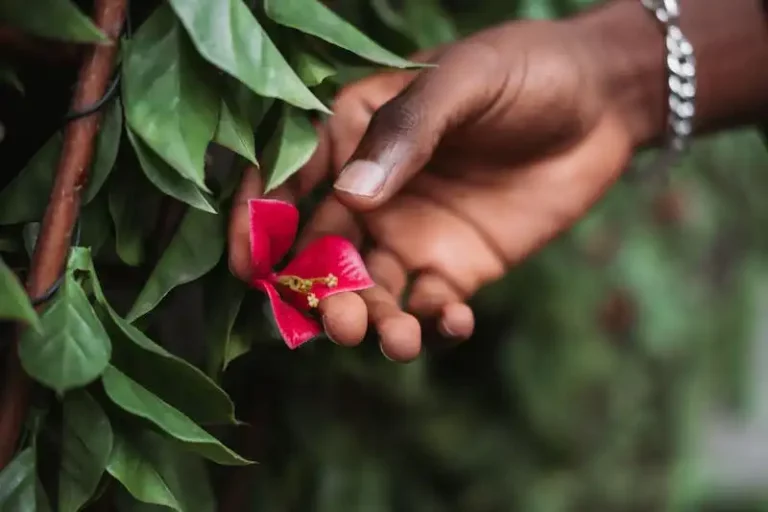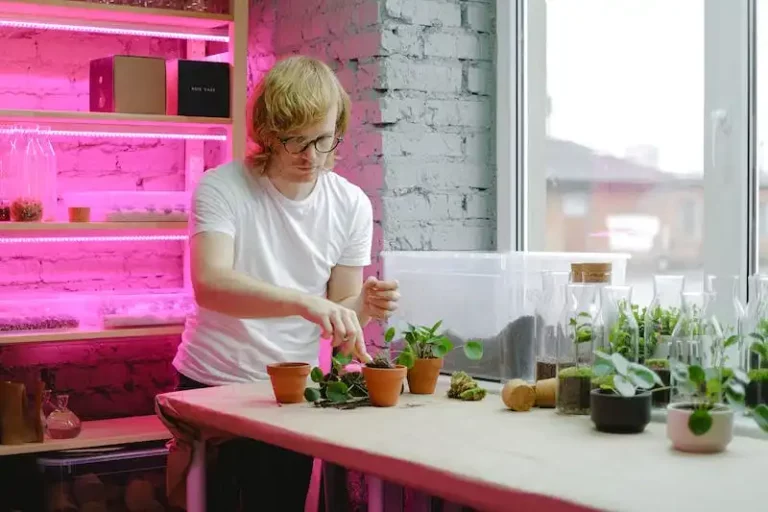Salvia elegans, commonly known as tangerine sage, is a herb that belongs to the mint family. It is native to Guatemala and is one of the least hardy salvias, which means it requires some protection during the colder months in zones below 9. This plant is known for its showy, bright red flowers that resemble hood-like cones. The foliage of Salvia elegans is also quite attractive, with its fuzzy, fertile stems and vibrant green color.
When growing Salvia elegans, it is important to choose a location that receives full sun or at least 6 hours of direct sunlight each day. It prefers well-drained soil and doesn’t tolerate overwatering. It is recommended to amend the soil with compost or organic matter before planting to ensure healthy growth. The plant starts to naturally propagate when its seeds are dropped on the ground, so it’s best to prune the plant regularly to maintain its shape and prevent it from becoming too dense.
Salvia elegans can be propagated by taking stem cuttings, which should be done in late spring or early summer. These cuttings should be around 4-6 inches long and rooted in a well-draining soil mix. If you choose to propagate from seeds, it’s best to sow them in early spring and keep the soil consistently moist. It’s important to note that Salvia elegans is not frost-tolerant, so it’s recommended to bring the plant indoors or protect it from freezing temperatures.
Salvia elegans is not very demanding when it comes to pests and diseases. However, it may attract aphids or spider mites, especially during periods of drought or high humidity. To minimize pest infestations, it’s important to provide adequate irrigation and maintain a proper balance of light and temperature. Regular pruning can also help prevent pest problems and promote healthy growth.
The colorful flowers of Salvia elegans make it a great addition to any garden or landscape. They can attract pollinators such as bees and butterflies, and the plant itself can be used as an attractive garnish. The leaves of Salvia elegans have a distinct tangerine aroma, which can be released by crushing or bruising the foliage. This plant can also be used in culinary applications, adding a citrusy flavor to various dishes and beverages.
If you’re looking for a plant that adds a splash of color and attracts pollinators to your garden, Salvia elegans is a great choice. Its vibrant flowers and aromatic foliage make it a standout in any landscape. Whether you’re a seasoned gardener or just starting out, Salvia elegans is an easy-to-grow and rewarding plant to cultivate. It’s sure to become a favorite in your garden.
For more information about growing and caring for Salvia elegans, including tips on pruning and temperature hardiness, please ask your local gardening center or consult reliable sources online. Updated resources and expert advice can help ensure the success of your Salvia elegans plants and answer any questions you may have along the way.
How to Plant and Grow Pineapple Sage
If you are a gardener who loves to experiment with interesting and unusual plants, then you should consider growing Pineapple Sage (Salvia elegans). This tender perennial herb is native to Mexico and Guatemala and is known for its beautiful red flowers, aromatic foliage, and pineapple-like scent.
Here are some tips for successfully growing Pineapple Sage:
1. Planting: Pineapple Sage can be grown from seeds or cuttings. If you are starting from seeds, sow them indoors about four to six weeks before the last frost date. Pineapple Sage seeds often take longer to germinate than other salvias, so be patient. When the seedlings are large enough to handle, transplant them into individual pots and grow them under lights until it is warm enough to plant them outside.
2. Location: Pineapple Sage prefers full sun but can tolerate some afternoon shade, especially in hot climates. It also needs well-drained, fertile soil. Add compost or organic matter to the soil before planting to improve its fertility and drainage.
3. Watering: Pineapple Sage plants like regular watering, especially during hot and dry spells. However, make sure not to overwater them as they can be prone to root rot. Water the plants at the base and avoid getting the foliage wet to prevent the development of fungal diseases.
4. Pruning: Pineapple Sage has an open-branched habit and can become leggy if not pruned regularly. Pinch back the tips of the plants to promote bushiness and encourage more blooms. Pruning also helps to keep the plant compact and tidy.
5. Frost protection: Although Pineapple Sage is generally frost-tender, some gardeners have reported that their plants have survived mild winters with only minimal protection. If you live in an area with cold winters, it is better to plant Pineapple Sage in containers that can be brought indoors or placed in a protected location during the winter months.
6. Companion planting: Pineapple Sage is a great companion plant for vegetables and herbs. Its aromatic foliage can help repel pests, and its showy red flowers attract pollinators. Plant it near tomatoes, peppers, melons, or borage to see the difference it can make in your garden.
In addition to its ornamental value, Pineapple Sage is also valued for its culinary uses. The leaves can be used as a flavorful garnish in salads, cocktails, and fruit dishes. The flowers can be used to infuse syrups, teas, or vinegars.
In conclusion, growing Pineapple Sage can be a rewarding experience for any gardener. Its attractive foliage, colorful blooms, and delightful fragrance will surely add a touch of beauty and spice to your garden. If you have any questions or need more information on how to grow Pineapple Sage, please consult your local gardening center or refer to reputable online gardening resources.
Source: News article
Pineapple Sage Overview
Pineapple sage (Salvia elegans), also known as tangerine sage or Mexican sage, is a herbaceous plant belonging to the Lamiaceae family. Originally from Mexico, it is a popular choice among gardeners for its beautiful inflorescence and delicious pineapple-like aroma.
Pineapple sage thrives in well-drained soil and requires regular watering to maintain good growth. It is good news for gardeners that this plant is relatively easy to grow from seeds or stem cuttings. When growing from seeds, it is best to start them indoors before the last frost and then transfer the young plants to the garden when the weather warms up.
One of the key features of pineapple sage is its vibrant red stems, which emerge from the tips of the plant. The older stems tend to become woody and turn brown at the bottom. The leaves of pineapple sage are green and have a hood-like shape, resembling the foliage of other salvias.
Pineapple sage is a fast-growing plant that makes a great addition to any garden. It is a cooperative plant that can improve the overall appearance of a flower bed by bringing in pollinators such as bees and butterflies.
When it comes to pests, pineapple sage is relatively pest-resistant, which is good news for gardeners. Some common questions that gardeners have when it comes to pineapple sage include when to start propagating and how to care for the plant.
Pineapple sage is typically harvested in late summer or early fall when the flowers appear. The plant can be used to spruce up salads and other dishes, adding a delicious pineapple-like flavor to the culinary creations. Pineapple sage can be harvested sequentially by cutting the open-branched stems from the bottom up.
Overall, pineapple sage is a versatile and attractive plant that is easy to grow and care for. Whether grown in greenhouses or in the garden, this compact plant with its delightful fragrance and vibrant appearance is sure to please both gardeners and culinary enthusiasts alike.
Where to Plant Pineapple Sage
Pineapple sage (Salvia elegans) is a native herb that grows well in a variety of conditions. It is a member of the salvia family, which is known for its showy blossoms and fragrant foliage. This late-blooming plant is a great choice for pollinator gardens and adds a pop of color to any landscape.
When deciding where to plant pineapple sage, there are a few factors to consider. First, it is important to choose a location with good sunlight. Pineapple sage thrives in full sun, although it can tolerate partial shade. At least six to eight hours of direct sunlight per day is ideal for optimal growth and flowering.
In terms of soil, pineapple sage prefers well-drained, slightly acidic soil. It performs best in soil that is rich in organic matter and does not hold excess moisture. Adding compost or organic matter to the planting area can help improve drainage and fertility.
Pineapple sage is a fast-growing herb that starts well from seed or from rooted stem cuttings. If starting from seed, it is best to start the seeds indoors in late winter or early spring. Plant the seeds in a potting mix and keep them moist until they germinate. Once the danger of frost has passed and the seedlings are well-established, they can be transplanted into the garden.
When transplanting pineapple sage seedlings, it is important to give them enough space to grow. The plants can reach a height of three to four feet and have a spread of two to three feet. Plant them at least two to three feet apart to allow for proper air circulation and prevent overcrowding.
Watering is an important aspect of pineapple sage care. While the plants prefer regular watering, they are somewhat drought-tolerant once established. It is important to avoid overwatering, as this can lead to root rot. Water the plants deeply and allow the soil to dry out slightly between waterings.
Pineapple sage is a cooperative bloomer and will continue to produce flowers throughout the growing season with proper care. Deadheading spent flowers can help promote continual blooming. Additionally, fertilizing the plants every four to six weeks with a balanced fertilizer can encourage healthy growth and flowering.
In terms of temperature, pineapple sage is hardy in USDA zones 8 to 10. In colder regions, it is best to treat it as an annual or grow it in a container that can be brought indoors for the winter.
Pineapple sage is a versatile plant that can be used in a variety of ways. The leaves have a strong pineapple scent and flavor, making them a great addition to food and drinks. They can be used fresh or dried for later use. The bright red flowers also add a pop of color to salads and desserts.
In summary, pineapple sage is a beautiful and useful plant that can be grown in a variety of conditions. With its showy blossoms, fragrant foliage, and cooperative blooming habits, it is sure to be a great addition to any garden or landscape.




